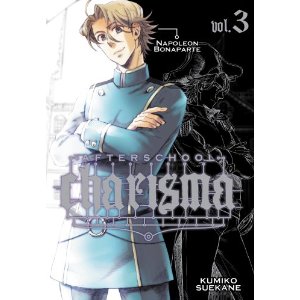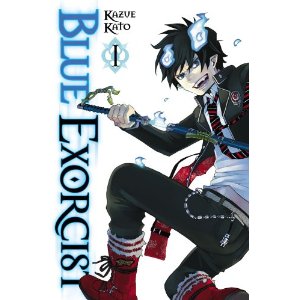Genkaku Picasso Volumes 1-3 by Usamaru Furuya
Genkaku Picasso is an interesting series, because the author Usumaru Furuya came out of the alternative manga scene in Japan with his earlier work featured in Garo. Genkaku Picasso is a series about a misanthropic young artist who gains the power to change the people around him when he is possessed by the artistic inspiration to draw their inner souls. This series had incredibly interesting and surreal art, but it felt to me like it wasn’t ambitious enough. I’m probably being overly critical because Furuya is so clearly talented, but I thought the story aspects of Genkaku Picasso let down the art a little bit. The series is still very much worth reading for the visual elements alone.
The first volume shows the lonely life of Hikari Hamura, nicknamed “Picasso” by his classmates at school due to his relentless drawing habit. He doesn’t really have any friends, but a girl in his class named Chiaki who finds him interesting and makes an effort to hang out with him. As they sit by a riverbank while Hikari is sketching, a horrible helicopter crash takes place. Chiaki is killed, but Hikari survives. Chiaki is transformed into a mini-angel who lives in Hikari’s pocket and his talent at sketching takes on a mystical turn. Chiaki informs him that his arm is starting to rot and the only way that he can save himself is to start helping other people. Hikari can now sense when a classmate is troubled. A dark aura manifests itself around Hikari’s next subject and he becomes possessed by a strange muse, compulsively drawing a depiction of his classmate’s inner heart. Hikari then can leap into his own drawing and experience the surreal scene he created, and his actions inside the drawing can cause the tormented soul to change for the better.
Hikari’s first subject is Sugiura, whose inner landscape is dominated by a crumbling cliff, amusement park, and an angry giant clutching a bag of money. While Sugiura is outwardly popular, his family life is less than ideal. As Hikari learns more about his classmate, the surreal pictures shift and change until Hikari is able to arrive at the truth of what is tormenting Sugiura. One of the things I liked very much about this manga was the way the illustration style would change depending on the world Hikari inhabits. The real world has all the polish and screentone of a standard manga, but when Hikari is transported into one of his illustrations it becomes more unfinished, with crosshatching used for shading and a slightly grainy quality that evokes the idea of a pencil or charcoal sketch.
Hikari continues to help his classmates, but his erratic behavior (he looks like he’s talking to himself when he’s talking to Chiaki) and his habit of abruptly passing out (which happens when he disappears into a drawing) still causes most of his classmates to shun him. He does manage to inspire feelings of affection in the people he helps, and he’s soon surrounded by a circle of acquaintances who are now taking more of an active interest in him.
One of the things that bothered me about this manga throughout the first couple volumes was the fact that Chiaki doesn’t seem to mind at all her transformation into Hikari’s nagging Tinkerbell. Even though while she was alive she inexplicably supported Hikari, I thought it was odd that she didn’t have more of a reaction to her fate. Genkaku Picasso is fairly episodic, but I did like some of the stories where there would be a shift towards Hikari exploring the inner life of a character that appeared briefly before. Hikari helps a boy in his class named Mamba finally work through his feelings towards a girl named Ogura. Mamba’s images evoke a sinister tree binding the girl he likes. Later Hikari visits Ogura’s subconsciousness and sees that her inner life is filled with mecha and yaoi imagery.
Some of Hikari’s solutions sometimes seem a bit simplistic, and this was particularly the case when Hikari helped one of his classmates who happened to have gender identity issues. The story ends very happily, which is nicely affirming if unfortunately not very realistic. One of the rewarding things about Genkaku Picasso is seeing the differences in the inner lives of Hikari’s targets. Joan of Arc, a Disney take-off, pop idols, childhood toys, and surreal gardens form the mind landscapes of Hikari’s classmates.
The third volume moves away from the more episodic storytelling of the first two volumes, finally providing some answers to questions readers may be forming about Hikari’s strange behavior, and if he’s ever going to turn his powers of artistic observation on himself. In his final journey, Hikari delves into his own psyche but he finds himself absolutely alone, without Chiaki. Hikari’s classmates begin to get worried about where he might be and they decide to go on their own rescue mission. We finally see some of the back story of the accident where Chiaki was killed, and there are some incredibly arresting images of Hikari trying to peer out of his own eyeball as though he were separating out the slats of a window shade that are going to stay in my memory for a long time.
The ending is heartwarming, with a dash of fake-out. While the story was concluded in an emotionally affecting manner, it seemed a bit too easy for me somehow. This goes along with my earlier reaction of the basic premise of the book. I think that there are some problems that just can’t be solved nicely with some surreal sketching and psychological intervention from a socially maladjusted teenager. I’m glad I read Genkaku Picasso, because it is so visually innovative and serves as a great contrast to the usual type of shonen series that get translated here. My frustration with the series remains because I think Furuya’s artistic talent is so great that he’s clearly capable of producing a classic work, but Genkaku Picasso isn’t it. Maybe I’d be better off reading some of his manga where he’s adapting another writer’s work. I still enjoyed Genkaku Picasso and would recommend it to anyone wanting to read visually striking manga.
Review copies of volumes 2 and 3 provided by the publisher.



